
a web page by Don Roberson |
REED WARBLERS Acrocephalidae |
|
 |
Traditionally, this subset of the Old World warblers was comprised of four genera: Acrocephalus "reed-warblers," Hippolais "tree-warblers," Chloropeta "yellow-warblers" in Africa, and Nesillas "brush-warblers" in Madagascar and the Comoros. After extensive molecular review, Fregin et al. (2009) re-arranged the family conservatively, leaving the current composition of five genera: Acrocephalus "reed warblers" (39 species), core Hippolais warblers (4 species), Iduna warblers (8 species that group together from 3 different former assignments, including two of the Chloropeta warblers; more below), Calamonastides (Papyrus Yellow-Warbler, formerly in Chloropeta), and the four Nesillas brush-warblers of Madagascar and the Comoros (plus another, N. aldabrana from Aldabra I., that is extinct). |
 |
In contrast, there are places where other reed warblers — like this one in the Baliem Valley in montane New Guinea (right) — walk up on a stalk into the open to sign vigorously when setting up territories. For many years this New Guinea population was considered part of a widespread species called "Clamorous Reed Warbler" but this population is now assigned to Australian Reed Warbler [but stay tuned for future splits.] Clamorous Reed Warbler A. stentoreus — named for its loud songs on breeding grounds — is now restricted to populations from the Middle East through India, and also in the Philippines and western Indonesia. It breeds in a variety of reedy habitat, including Papyrus (Cyperus) stands, reeds (Phragmites) around lakes and along rivers, reedmace (Typha), mangroves, Pandanus, and elephant grass (Dyrcz 2020). |
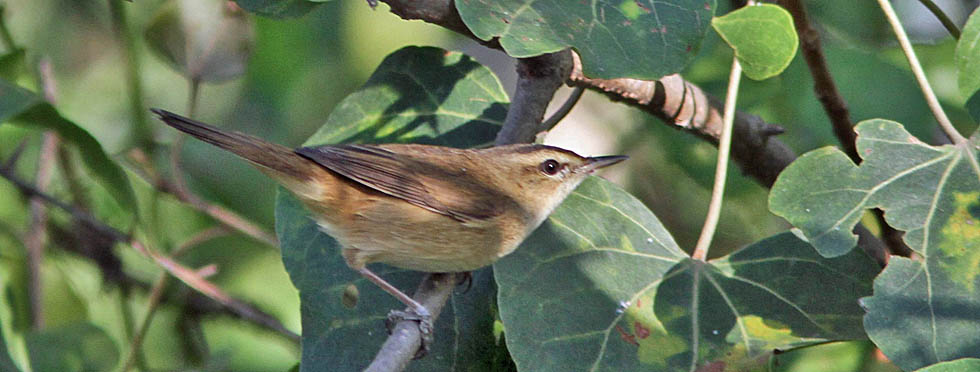 |
The migrant species include long-distance migrants that can reach Europe as vagrants, and therefore there is a keen interest in identification material (much of it summarized in Kennerley & Pearson 2010). These will also intrigue winter visitors to south Asia. Black-browed Reed Warbler, for example, breeds in marshes in eastern China, Korea, and Japan (see the habitat shown in a photo up the page) and then skulks in winter in wetlands in south-east Asia (photo just above, taken at Christmas in Thailand). As similar-appearing species — Streaked Reed Warbler Acrocephalus sorghophilus — winters almost entirely in the Philippines, and is suffering declines as its wintering marshes are converted to cultivation. Tropical and southern hemisphere species are most resident. These include Australian Reed Warbler (left) and African Reed Warbler A. baeticatus. There is an impressive set of reed warblers on islands in the Pacific, many of them island endemics. Cibois et al. (2011) used molecular evidence to evaluate western Pacific Acrocephalus and found a number of overlooked species. Sadly, Pagan Reed Warbler A. yamashinae, Mangareva Reed Warbler A. astrolabii, Leeward Islands Reed Warbler A. musae and Moorea Reed Warbler A. longirostris are among the six Pacific reed warblers that have already become extinct [the extinct Acrocephalidae are excluded from the Family totals at the top of this page]. Pacific Ocean reed warblers include birds way out in the middle of the Pacific, including Millerbird A. familiaris of Nihoa I., Hawaii, and Pitcairn Reed Warbler A. vaughani. Many of these island populations are threatened or endangered. What may be most fascinating about these oceanic-island reed warblers is that they colonized the Pacific in at least three different waves of colonists. The DNA evidence (Cibois et al. 2011) shows that in some places, like the Marquesas, reed-warblers on islands only 41 km apart arose from completely different waves of immigrants, and thus each is more closely related to birds on islands thousands of miles distant than they are to the reed-warblers on the next island over. |
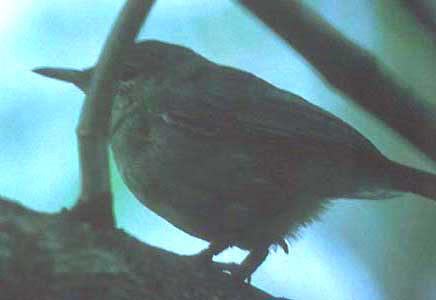
There are also reed warblers in the Indian Ocean, including Seychelles Reed Warbler (right). This species has a very tiny range and nearly went extinct. There were only 29 individuals located in 1959, on a single tiny island — Cousin I. (29 ha in size). The island became a nature reserve in 1968 and habitat management led to increase in numbers: 323 birds by 1997, thought to be the island's capacity. Many breeding pairs had nest-helpers. Portions of the population were translocated to Cousine and Aride, where those populations are growing. It is one of the world's best success stories of saving a species from extinction (Bairlein 2006). |
Finally, Thick-billed Warbler, formerly "Acrocephalus" aedon — is also placed in its own monotypic genus Arundinax. I also think of the shrub Lantana when I think of Thick-billed Warbler, because the few I've seen in winter in eastern India were seemingly tied to a patch of Lantana. The genus Acrocephalus once included what some called "the least known bird in the world": Large-billed Reed-Warbler A. orinus. It had been known from a single specimen taken in northern India in 1867. This changed when a migrant was discovered in Thailand in 2006, and then the breeding grounds were discovered in northeastern Afghanistan (Timmons et al. 2012). Thus there is still much to learn about the Acrocephalidae, including the actual number of species. Many east Asian, Melanesian, and west Pacific populations are poorly known. This family was recently evaluated for genetic distance between populations, and serves as a cautionary tale about the using genetic distance, and nothing else, to come to species level conclusions. Genetic distance is just part of the answer — it is not, standing alone, "the" answer as some who propose "bar-coding" suggest (Fregin et al. 2012). |
Photos: The Eurasian Reed Warbler Acrocephalus scirpaceus was at Sham-el-sheik, Sinai Peninsula, on 7 Nov 1981. Blake Matheson photographed the Sedge Warbler A. schoenobaenus at Rocio, Huelva, Spain, in March 2004. The habitat shot of Xinghai Reserve, Jilin, China, — home to three breeding Acrocephalus —was taken on 13 June 2004. The singing Australian Reed Warbler A. australis in the Baliem Valley, Papua Province (formerly Irian Jaya), Indonesia, on 31 July 1994. The Black-browed Reed Warbler A. bistrigiceps was at the Muang Boran marsh, near Bangkok, Thailand, on 31 Dec 2012. The second example of Australian Reed Warbler A. australis was at the Dulkaninna Station, along the Birdsville Track, South Australia, on 19 Nov 2009 — in the extremely dry desert in Australia's center. The Olivaceous Warbler Iduna pallida was at Persepolis, Iran, on 9 Aug 1978. The Seychelles Reed Warbler A. sechellensis was on Cousin I., Seychelles, on 13 Nov 1992. Photos © Don Roberson, except that attributed to Blake T. Matheson, used with permission; all rights reserved. No book review was posted on the first version of this family page in 2012, as I'd not read either of the books that covered the Family and that had appeared in 2010 and 2012. I'm pleased to remedy this defect by adding reviews of those publications by guest reviewer Murray Lord of Sydney, Australia: Family book: Rating
Family book: Rating
Literature cited:
|
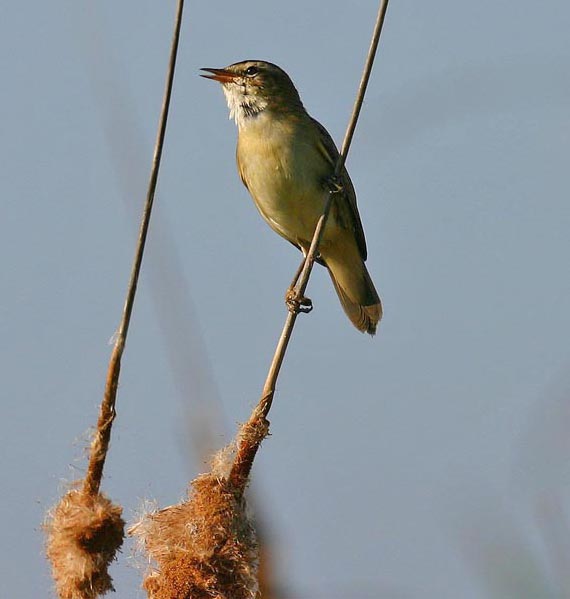 The Acrocephalidae is a new family created by the "
The Acrocephalidae is a new family created by the "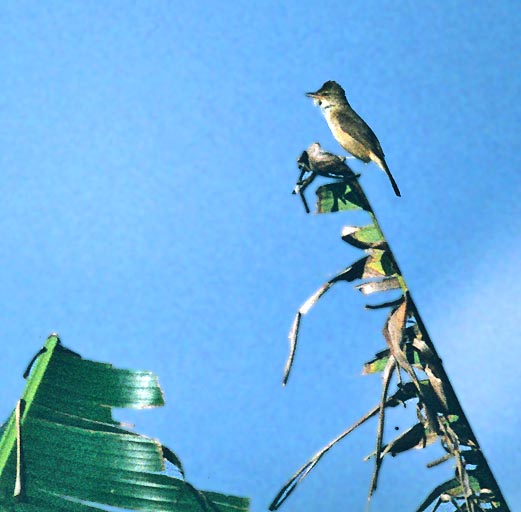 Reed-warblers typically breed in extensive marshes, such as this one in Xinghai Nature Reserve, northeastern China (above). Oriental A. orientalis, Black-browed A. bistrigiceps, and Manchurian A. tangorum all breed in this marsh and, with effort, each of the skulking songsters was viewed reasonable well — but not without wet feet! Field identification of Acrocephalus warblers can be a major challenge. Literature used in China, for example, to sort out the rather local Manchurian Reed Warbler, included Alström et al. (1991) and Leader & Lewthwaite (1996).
Reed-warblers typically breed in extensive marshes, such as this one in Xinghai Nature Reserve, northeastern China (above). Oriental A. orientalis, Black-browed A. bistrigiceps, and Manchurian A. tangorum all breed in this marsh and, with effort, each of the skulking songsters was viewed reasonable well — but not without wet feet! Field identification of Acrocephalus warblers can be a major challenge. Literature used in China, for example, to sort out the rather local Manchurian Reed Warbler, included Alström et al. (1991) and Leader & Lewthwaite (1996). All of the Palearctic members of the Acrocephalidae are migrants, moving south of winter in African, India, or southeast Asia. Tropical species are generally sedentary.
All of the Palearctic members of the Acrocephalidae are migrants, moving south of winter in African, India, or southeast Asia. Tropical species are generally sedentary.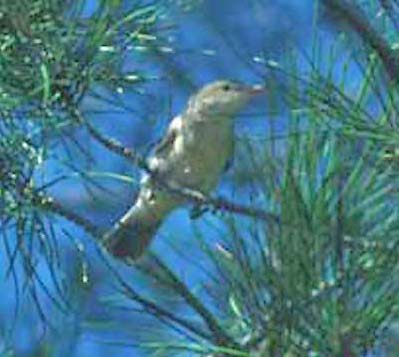 The DNA evidence now restricts Hippolais warblers to just four core species: Booted H. caligata, Melodious H. polyglotta, Olive-tree H. oivetorum, and Upcher's H. languida. The remaining four previous "hippos" are now assigned to genus Iduna, including Olivaceous Warbler, shown here (left) as a migrant in Iran. It is now split from I. opaca, the Isabelline Warbler ("Western Olivaceous Warbler"). Two of the yellow-warblers of Africa are included in Iduna: African Yellow-Warbler, now I. natalensis, and Mountain Yellow-Warbler, now I. similis. But Papyrus Yellow-Warbler gets its own monotypic genus, and becomes Calamonastides gracilirostris; Fregin et al. (2009).
The DNA evidence now restricts Hippolais warblers to just four core species: Booted H. caligata, Melodious H. polyglotta, Olive-tree H. oivetorum, and Upcher's H. languida. The remaining four previous "hippos" are now assigned to genus Iduna, including Olivaceous Warbler, shown here (left) as a migrant in Iran. It is now split from I. opaca, the Isabelline Warbler ("Western Olivaceous Warbler"). Two of the yellow-warblers of Africa are included in Iduna: African Yellow-Warbler, now I. natalensis, and Mountain Yellow-Warbler, now I. similis. But Papyrus Yellow-Warbler gets its own monotypic genus, and becomes Calamonastides gracilirostris; Fregin et al. (2009). 